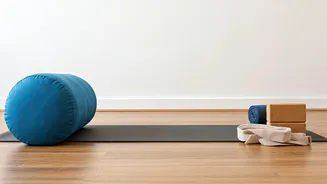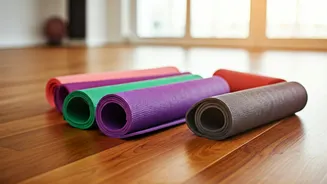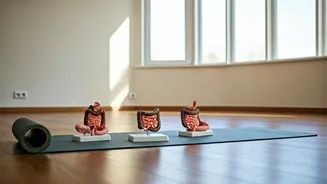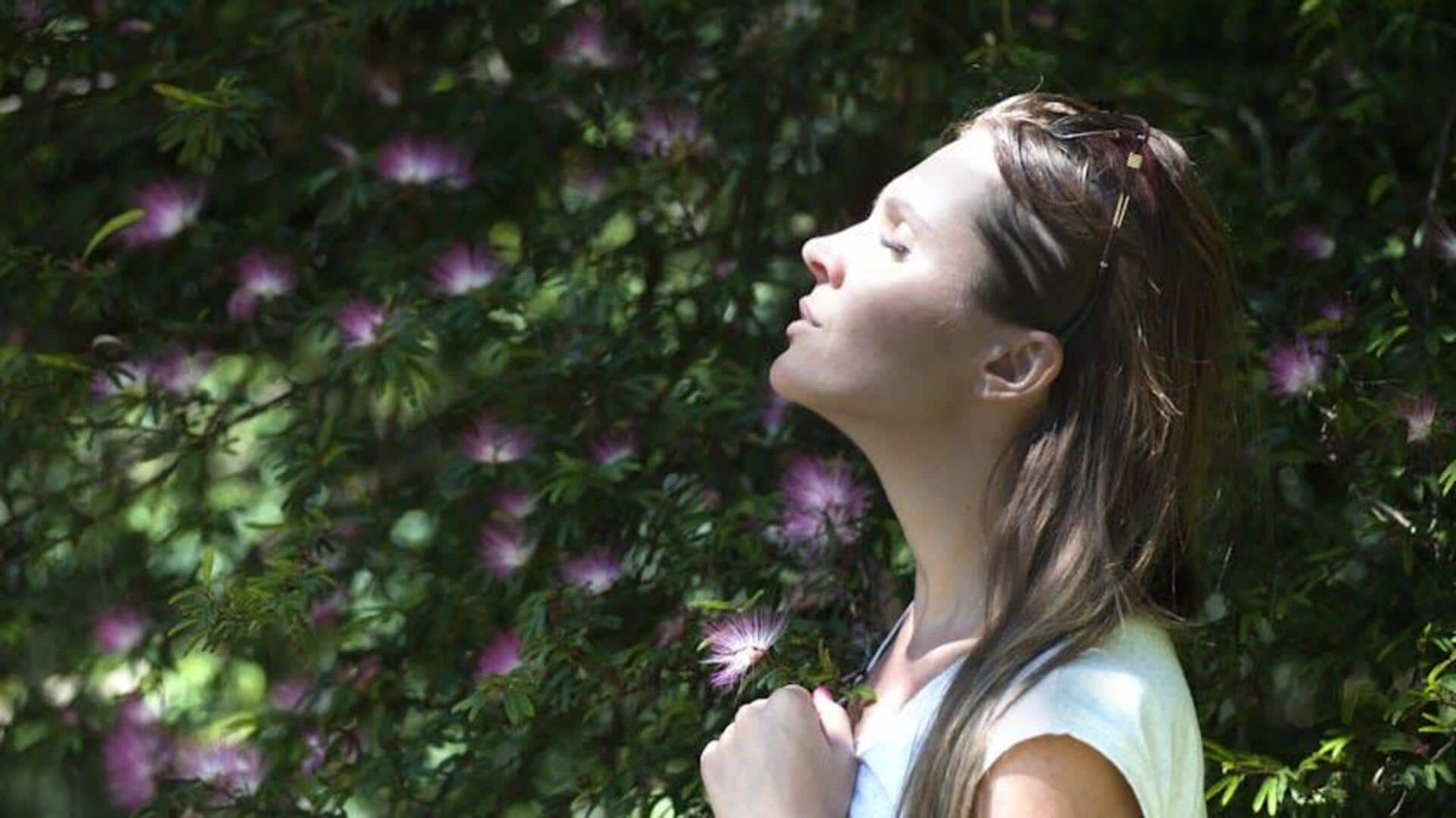Understanding Digestive Issues
Before exploring the specific poses, it's essential to grasp the common causes of digestive issues like gas and bloating. Diet often plays a significant
role; foods high in fiber can sometimes lead to increased gas production. Rapid eating or swallowing air while eating can also contribute. Furthermore, stress and an inactive lifestyle can negatively impact the digestive system, leading to discomfort. Understanding these factors helps you better address the root causes of your symptoms. These yoga poses offer a gentle way to stimulate your digestive system and reduce discomfort, supplementing dietary adjustments and lifestyle changes for comprehensive digestive health management. Remember that if your issues persist or worsen, consulting a healthcare professional is vital to identify the underlying cause and seek appropriate medical advice.
Wind-Relieving Pose (Pavanamuktasana)
Pavanamuktasana, or the Wind-Relieving Pose, is a fundamental yoga posture particularly beneficial for easing gas and bloating. To practice this pose, start by lying on your back. Then, draw your knees towards your chest, gently hugging them with your arms. You can also gently rock side to side to massage your abdomen. This action compresses the abdominal region, helping to release trapped gas and stimulating the digestive organs. Hold the pose for several breaths, focusing on slow, deep inhales and exhales. Regularly practicing this pose can improve digestion and reduce bloating. Avoid this pose if you have any recent abdominal injuries or severe back pain. Always listen to your body and stop if you feel any discomfort.
Seated Spinal Twist (Ardha Matsyendrasana)
The Seated Spinal Twist, or Ardha Matsyendrasana, aids digestion by gently massaging the abdominal organs and stimulating peristalsis, the wave-like muscle contractions that move food through the digestive tract. To perform this twist, sit with your legs extended, bend one knee and place the foot on the floor. Then, cross your opposite arm over the bent knee and twist your torso towards the bent leg, looking over your shoulder. The gentle twisting action helps to compress and decompress the abdominal organs, improving their function. Hold the pose for several breaths, then repeat on the other side. This pose also enhances flexibility and reduces stress, which can significantly impact digestive health. If you have any back injuries, approach this pose with caution and modify it as needed. Focus on gentle movements and proper alignment to gain its full benefits.
Child's Pose (Balasana)
Child's Pose, or Balasana, is a restorative posture that promotes relaxation and can ease digestive discomfort. To enter this pose, kneel on the floor, and then sit back on your heels. Next, bring your forehead to the ground and extend your arms forward, relaxing your shoulders. The gentle compression on the abdomen in this pose helps to release tension and can relieve bloating and indigestion. Child's Pose is also known for its calming effects, which can reduce stress, a significant factor contributing to digestive issues. Breathe deeply into your abdomen, allowing it to expand and contract with each breath. This pose is very calming and can be a good way to end your practice. This posture offers comfort, helping the body to recover and restore equilibrium. Remember to adjust the posture according to your comfort level.
Cobra Pose (Bhujangasana)
Cobra Pose, or Bhujangasana, stimulates the digestive fire, or Agni, and improves digestion. To perform this pose, lie face down on your mat with your hands under your shoulders, elbows close to your body, and your feet extended. As you inhale, lift your chest off the floor while keeping your lower body grounded. This backbend gently compresses the abdominal organs, stimulating digestion and relieving constipation. Avoid overextending your back; the key is to lift with your chest, not your lower back. Cobra Pose is a fantastic posture to encourage good digestion. It not only enhances digestion, but also strengthens the spine and opens the chest. Those with back injuries or carpal tunnel syndrome should approach this pose with caution or avoid it and find alternatives.
Bow Pose (Dhanurasana)
Bow Pose, or Dhanurasana, offers a powerful boost to digestive function. To get into the pose, lie on your stomach with your arms at your sides and bend your knees. Reach back and grab your ankles. As you inhale, lift your chest and thighs off the floor, creating a bow shape with your body. This pose effectively compresses the abdomen, stimulating digestive organs and relieving bloating. Bow Pose enhances digestion and also helps to improve posture and strengthen back muscles. Breathe deeply and maintain the posture for a few breaths. This is another back bending pose; people with back injuries should perform this with caution. Always be mindful of your body and practice under the guidance of an experienced instructor if you're new to this pose.
Standing Forward Bend (Uttanasana)
Standing Forward Bend, or Uttanasana, can aid digestion by stretching and massaging the abdominal organs. Begin by standing with your feet hip-width apart. Inhale, and as you exhale, hinge at your hips and fold forward, aiming to touch your hands to the floor, keeping your knees slightly bent to avoid straining your hamstrings. This pose encourages blood flow to the digestive system, which can relieve bloating and improve digestive function. The stretch increases space within the abdominal area, which enables better digestion and elimination. Keep the pose for a few breaths, allowing your head to relax towards the floor. This gentle inversion pose is safe for most, but consult a doctor if you are pregnant or have any neck or back issues. Be very mindful of how your body feels as you move into and out of the posture.
Triangle Pose (Trikonasana)
Triangle Pose, or Trikonasana, is known to be a powerful pose that supports digestion. Start by standing with your feet wide apart. Turn one foot out to a 90-degree angle, and the other foot slightly inwards. Extend your arms out to the sides. Then, bend at your hip towards your outstretched leg, bringing your hand towards your shin, ankle, or the floor (depending on your flexibility). Lift your other arm towards the ceiling and gaze upwards. This side stretch gently massages the abdominal organs. This action promotes digestion by increasing blood flow to the abdominal area. Hold the pose for several breaths, then switch sides. Make sure your torso is aligned to get the most advantages from the pose. Those with high blood pressure or neck issues should adapt the pose to fit their condition.
Supported Bridge Pose (Setu Bandhasana)
The Supported Bridge Pose, or Setu Bandhasana, offers a gentle way to enhance digestion. Lie on your back with your knees bent and your feet flat on the floor, hip-width apart. Place a block or a cushion under your sacrum (the bony part at the base of your spine). This gentle lift helps to stretch the abdominal muscles and stimulate the digestive organs. It also promotes relaxation, which aids in reducing stress-related digestive problems. Hold the pose for several breaths, focusing on deep belly breathing. This is a less strenuous variation that provides similar benefits to the full bridge pose without the intense spinal movement. This is a great starting point for many to experience the benefits of a supported bridge pose. Listen to your body.
Reclining Twist (Supta Matsyendrasana)
Reclining Twist, or Supta Matsyendrasana, is a gentle twist that massages the abdominal organs and aids in digestion. Begin by lying on your back with your knees bent and your feet flat on the floor. Draw your knees towards your chest, and then gently lower them to one side, keeping your shoulders flat on the floor. Extend your arms out to the sides. This gentle twist helps to stimulate peristalsis and release trapped gas. Hold the pose for several breaths, focusing on deep, abdominal breathing, and then switch sides. It also reduces stress and improves spinal flexibility, which helps your body overall. This pose promotes relaxation, which contributes to better digestion and overall well-being. Always perform these poses in a safe and controlled way.





